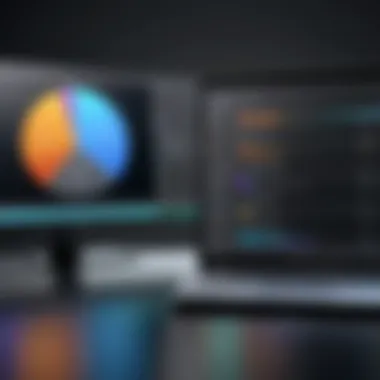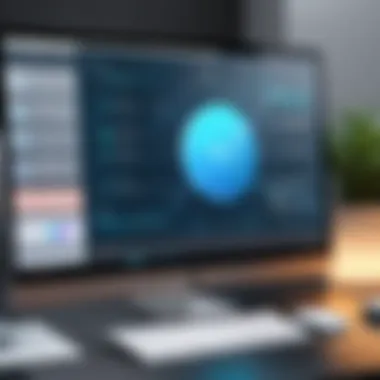Top Lumion Alternatives: A Detailed Software Guide


Intro
In the realm of architectural visualization, the software utilized can significantly influence the outcome of a project. While Lumion has carved a niche for itself with its impressive rendering capabilities, there are numerous alternatives that may cater to varied professional needs. This article delves into these options, providing an analytical overview of several software solutions designed for high-quality visual rendering.
Understanding the capabilities of these alternatives requires a meticulous examination of their features, performance, and pricing. By doing so, professionals can make informed decisions that align with their specific requirements and budgetary constraints. The goal is to empower users to optimize their software investments effectively while maintaining high standards in their visual presentations.
Key Software Features
Essential functionalities
A comprehensive exploration of rendering software necessitates a closer look at the core features that each option presents. Most software packages include basic functionalities, such as:
- 3D modeling: Ability to import or create 3D models.
- Rendering engine: Tools to handle lighting, shadows, and textures effectively.
- User interface: A clean and intuitive design that simplifies the workflow.
On top of these essentials, many alternatives to Lumion possess specialized features that enhance user experience and output quality. For instance, software like Twinmotion offers real-time rendering, allowing users to visualize changes immediately. Meanwhile, Enscape integrates seamlessly with popular modeling tools such as SketchUp and Revit, streamlining the workflow for architects.
Advanced capabilities
Beyond the basics, advanced functionalities distinguish various software offerings. These might include:
- Virtual reality support: Software like Unity allows users to immerse clients in a virtual tour of the project.
- Animation tools: Programs such as Blender provide enhanced capabilities for crafting animated presentations.
- Environmental simulations: Solutions like 3ds Max can simulate real-world environmental impacts on a design, which is crucial for sustainability assessments.
The inclusion of such advanced features can be pivotal, depending on the project requirements and the level of detail sought by the user.
Comparison Metrics
Cost analysis
When investing in rendering software, understanding the cost structure is vital. Pricing models can vary significantly, from subscription-based fees to one-time purchases. Many users might find that options like KeyShot offer competitive pricing for standalone licenses. In contrast, others like Unreal Engine provide free access with optional paid features, effectively lowering the barrier to entry.
Performance benchmarks
Evaluating performance is equally important. Metrics such as rendering speed, system resource usage, and the quality of output can significantly impact workflow efficiency. Software like V-Ray is renowned for its high-quality finishes, though it may require more powerful hardware to function effectively. Conversely, simpler software tools might run adequately on standard systems but may sacrifice quality in complex scenes.
"The choice of rendering software can dictate not just the quality of visual outputs, but also influence overall project timelines and client satisfaction."
This holistic understanding of expenses and performance is paramount for decision-makers seeking effective solutions to meet their architectural visualization needs.
Prelims to Lumion
When discussing architectural visualization, Lumion often comes up as a standard tool. It garners attention for its user-friendly interface and ability to produce impressive renders promptly. This section delves into the essence of Lumion, its functionalities, and why it stands as a prominent tool in the industry. Understanding Lumion's capabilities provides essential insights for professionals evaluating alternatives.
What is Lumion?
Lumion is a 3D rendering software specifically designed for architects and designers. It caters primarily to individuals who need to turn models into visually engaging presentations quickly. With its extensive library of materials, models, and environmental settings, Lumion allows users to create immersive scenes in real-time.
One can easily import models from popular CAD software, such as AutoCAD or SketchUp. Once integrated, users can manipulate lighting, textures, and weather conditions to enhance the visual appeal of their designs. The simplicity of operations combined with powerful rendering capabilities makes Lumion a popular choice among architects seeking efficiency and quality in their work.
Applications of Lumion in Industry
Lumion finds various applications across different sectors:
- Architectural Presentations: Architects use Lumion to create stunning visual presentations for clients. The ability to create realistic renderings helps communicate design intentions effectively.
- Urban Planning: Urban planners utilize Lumion to visualize large-scale projects. It offers a visual representation of how new constructions will fit into existing landscapes.
- Landscape Architecture: Designers in this field often employ Lumion to showcase outdoor spaces, providing a clear vision of vegetation, terrain, and architectural integration.
- Interior Design: Lumion helps interior designers visualize spaces, providing clients with realistic images of potential designs before the actual work begins.
"Lumion has revolutionized how we present our ideas. The ability to create stunning visuals quickly has changed our workflow significantly."
Considering Lumion's role within the industry highlights its importance and sets the stage for exploring viable alternatives. Users looking for different tools may find themselves considering factors like cost, functionality, and community support in their search. This exploration demonstrates how the architectural visualization landscape continues to evolve, much like the tools we use to create and present our designs.
Understanding the Need for Alternatives
In the realm of architectural visualization, choosing the right rendering software can significantly impact a project's success. While Lumion is a popular choice, it comes with specific limitations that can affect users' efficiency and output quality. This section aims to explore these deficiencies, as well as the growing demand for a variety of rendering tools that cater to diverse needs.
Limitations of Lumion
Lumion is widely recognized for its user-friendly interface and quick rendering times. However, it has limitations that can hinder its overall flexibility and functionality. One significant drawback is the dependence on specific hardware for optimal performance. Users with older machines may find their experience frustrating due to long rendering times and lagging during use.
Additionally, Lumion's library of objects and materials, while extensive, does not offer as much customization as some advanced users require. Many professionals wish to incorporate their own assets seamlessly into a project. The software can also be expensive for some firms, especially smaller ones facing budget constraints. All these aspects combine to create a pressing need for alternatives that offer enhanced customization and versatility.


Demand for Diverse Tools
The architectural and design industries are evolving, with professionals seeking tools that cater to their specific project needs. This demand underlines the necessity for software that not only matches Lumion's basic capabilities but also exceeds them in critical areas like customization, rendering quality, and integration with other applications.
Here, we observe several trends driving this demand:
- Specialization: Different projects may require specialized features. For example, interior designers might need software focused on lighting and materials, while urban planners could prioritize large-scale visualization tools.
- Adaptability: Professionals need software that can adapt to various workflows and project scopes. This adaptability is crucial for teams that deal with diverse projects across different sectors.
- Community and Support: As users become more discerning, they seek alternatives that provide robust support systems and active user communities. Engaging with other professionals can lead to enhanced learning and troubleshooting resources.
With these demands in mind, it becomes clear that exploring alternatives to Lumion is not merely an option but a necessity for many professionals aiming for excellence in their projects.
Criteria for Software Selection
Choosing the right software for rendering is crucial for professionals in architecture and design. As Lumion has its unique strengths, alternatives must also meet specific criteria to ensure they efficiently fit user needs. The following criteria serve as a guide to aid decision-makers in selecting suitable alternatives for their projects.
Functionality and Features
Functionality relates directly to what the software can accomplish. Users should assess the specific features offered by each alternative. For instance, if a project emphasizes real-time rendering, tools like Unreal Engine may excel in this area, whereas other options focus on detailed textures and lighting.
Key functionalities to consider include:
- Real-time rendering capabilities
- Support for various file formats
- Availability of assets and libraries
- Customization options
Understanding these features can help in determining how well the software aligns with project requirements, enhancing the overall output.
Ease of Use
Usability significantly impacts the learning curve and user's productivity. If software is overly complicated, it can hinder the creative process. Thus, it's vital to choose software that provides an intuitive experience.
Factors to evaluate might include:
- User interface design
- Availability of tutorials and documentation
- Community support for troubleshooting
The aim is to facilitate a smoother operational experience, allowing the user to focus on creativity rather than grappling with software complexities.
Cost Considerations
Price is often a deciding factor. However, it is important to look beyond the initial purchase cost. Consider total cost of ownership, which may include:
- Subscription fees
- Cost of updates
- Training expenses
Selecting software that provides good value for money without compromising on features is critical. Scouting for flexible pricing models or trial versions can also aid in making an informed decision.
Support and Community
Good support and a vibrant community are essential for resolving issues and enhancing usability. Check if the software has:
- Access to a dedicated support team
- Active forums for user interaction
- Frequent updates and bug fixes
A strong community signifies that users can share insights, which fosters an environment of continuous learning and improvement. This aspect often enhances user confidence in adopting the software.
Comparative Analysis of Lumion Alternatives
In this section, we focus on the comparative analysis of alternatives to Lumion, which is crucial for professionals in fields like architecture and design. As technology evolves, so do the tools available for visual rendering. Exploring alternatives can offer significant advantages. By understanding various software options, users can determine which tools align best with their specific needs.
A comprehensive analysis is not just about identifying features but also evaluating performance, user experience, and integration capabilities. Each tool has distinct strengths and weaknesses, and a nuanced comparison helps to highlight these differences. This ensures that potential users can make informed decisions that support their creative and business objectives.
SketchUp
SketchUp is a user-friendly software that offers intuitive modeling capabilities. It is widely recognized for its ease of use, making it an ideal starting point for beginners. The simplicity of its interface allows designers to create 3D models quickly. Advanced features, including plugins, enhance its functionality, catering to more experienced users.
- Key Features:
- Simple modeling tools
- Extensive library of pre-made models
- Compatibility with various file formats
SketchUp integrates well with rendering tools like V-Ray, enabling users to enhance their models with high-quality visualizations. Its strong community support provides ample resources for users seeking guidance and inspiration.
Twinmotion


Twinmotion offers real-time rendering capabilities, which is a significant draw for many professionals. It allows users to create immersive environments quickly. The drag-and-drop feature simplifies the design process substantially.
- Key Benefits:
- Real-time visualization
- Easy to use with a clear interface
- Good compatibility with architectural software
In addition, Twinmotion’s library of materials and objects is extensive, giving users the tools to enrich their projects. While its pricing model is competitive, potential users should assess its advanced features to see if they align with their project requirements.
Unreal Engine
Unreal Engine is a powerhouse in the rendering world, primarily known for its gaming capabilities. However, it has gained traction in architecture for its unparalleled visual quality. This software caters to professionals looking for high-end renderings and complex scene compositions.
- Notable Aspects:
- High-quality graphics
- Extensive customization options
- Strong support for VR
Despite its steep learning curve, Unreal Engine provides exceptional value for those willing to invest time in mastering its features. It is ideal for projects demanding highly detailed realism and interactivity.
Enscape
Enscape is specifically designed for architects and designers. Its main advantage lies in its ability to integrate seamlessly with popular CAD software like Revit, SketchUp, and Rhino. This integration allows users to visualize their projects instantly without lengthy export processes.
- Advantages:
- Instant rendering within the CAD environment
- User-friendly with real-time feedback
- Strong emphasis on virtual reality readiness
As Enscape focuses on architectural visualization, it is a robust option for professionals wanting efficient and high-quality renderings.
V-Ray
V-Ray is a highly respected rendering engine known for its photorealistic capabilities. It is widely used across various industries, including film and gaming, besides architecture. V-Ray complements software like 3ds Max and SketchUp, significantly enhancing rendering quality.
- Characteristics:
- Comprehensive lighting options
- Advanced materials and textures
- Extensive rendering features
While V-Ray requires some time to learn, its outcomes can be dramatic. Beginners may find the initial setup challenging but its high-quality results make it worth the effort.
3ds Max
3ds Max is another heavyweight in the 3D design space. It is widely recognized for its comprehensive modeling and animation tools. Professionals use it for both architectural visualization and graphic design projects. Its versatility sets it apart from simpler tools.
- Key Attributes:
- Robust modeling & animation tools
- Extensive material editor
- Good integration with other software
3ds Max's capabilities allow for intricate designs. While it may demand more investment regarding time and training, it provides flexibility for advanced users.
The comparative analysis of these software choices offers clarity on their capabilities, enabling users to choose a tool aligned with their project needs. By weighing options like SketchUp, Twinmotion, Unreal Engine, Enscape, V-Ray, and 3ds Max, professionals can harness the strengths of each to achieve their architectural goals.
User Experience Insights
Understanding user experience is paramount when selecting software alternatives to Lumion for architectural visualization. It encompasses how users interact with the software, the efficiency of these interactions, and the overall satisfaction derived from using the tool. As various options are available in the market, professionals must evaluate each alternative not just on features alone but also based on the experience they provide.
Key elements of user experience include interface usability, rendering speed, and the quality of output. Each of these aspects contributes significantly to the workflow and productivity of users, impacting decisions made by industry professionals. Considerations about these elements help ensure that the selected software is aligned with the specific requirements of users, thereby optimizing their creative and operational processes.
Interface and Usability
The interface of rendering software should be intuitive and user-friendly. A well-designed interface helps users to navigate easily, reducing the learning curve typical with new applications. Features such as drag-and-drop functionalities and customizable toolbars enhance usability, making the interaction smoother.
Since decision-makers depend on quick and effective visualizations, usability cannot be overstated. Software that presents a steep learning curve can lead to frustration and decreased productivity. This can be particularly detrimental when project deadlines are tight.
Moreover, comprehensive documentation and tutorial support can significantly improve the usability experience. When users feel empowered to use a tool efficiently, their creative output tends to flourish. Thus, a strong focus on usability should be an essential criterion for evaluating software alternatives.
Rendering Speed
Rendering speed is a critical factor for any visualization tool. When working on complex architectural models, quick rendering times can make a substantial difference. Users often seek software that can process images in real-time, allowing for immediate feedback during the design process. This capability not only enhances creativity but also helps in maintaining workflow momentum.


Slow rendering speeds can hinder the decision-making process. In a fast-paced environment, stakeholders may require visualizations for presentations or client meetings. As such, software alternatives must be evaluated thoroughly based on their rendering performance to avoid bottlenecks in project workflows.
Quality of Output
Quality of output is an indicator of how well a software can represent designs accurately and aesthetically. Users expect high-definition renderings that capture intricate details and realistic textures. The end visualization should reflect the user's vision with clarity and precision.
Additionally, the choice of software should support various rendering styles and settings. Whether it is a photo-realistic view or a more abstract representation, flexibility in output quality is necessary to meet different project demands. By assessing the quality of output among alternatives, decision-makers can ensure that the tool will meet both their current and future needs effectively.
"In a world where first impressions matter, quality visualizations are essential for success in architectural presentations."
Case Studies of Alternative Applications
Case studies are vital in understanding how various software alternatives to Lumion perform in real-world scenarios. They offer clear insights into the specific applications of these tools within the architectural and design realms. By analyzing actual projects, we can glean the advantages and challenges faced by professionals when utilizing different rendering solutions.
Gaining knowledge from these examples aids decision-makers in selecting software that best meets their needs. Each case highlights not just the outcomes but also the process involved, demonstrating the effectiveness and efficiency of different tools in various contexts. This examination plays a crucial role in shaping one’s understanding of the rendering landscape.
Architectural Projects
In architectural projects, various software options offer unique benefits. For instance, SketchUp is often favored for its ease of use and quick modeling capabilities. Architectural firms have adopted SketchUp for preliminary designs, allowing teams to produce models swiftly. Once the initial design receives approval, the transition to more advanced rendering software, like V-Ray, takes place to enhance visual appeal.
Another notable example is Twinmotion. It is often chosen for its real-time rendering capabilities, enabling architects to create immersive environments and walk-throughs during client presentations. This immediate feedback can be essential in client relationships.
Interior Design Applications
Interior designers leverage tools like Enscape and 3ds Max to visualize spaces effectively. Enscape’s real-time rendering allows designers to explore various design options without extensive wait times. Designers can rapidly switch textures, furniture, and layouts while conveying their vision more effectively to clients.
3ds Max is typically used for more intricate detailing and photorealism. It is ideal for high-end interior projects that demand precise visual representation, ensuring that every detail is captured. By highlighting these applications, it shows how tools can shape design decisions and outcomes.
Urban Planning Visualization
In urban planning, visualization software has a different focus. Tools like Unreal Engine are employed to create detailed simulations of urban scenarios allowing planners to visualize developments and their impacts on the environment. Such visualizations become critical during public consultations or presentations to stakeholders, providing a clear picture of proposed changes to a community.
Additionally, software like CityEngine is designed specifically for urban contexts. It helps in generating 3D city models based on geographic data. This capability aids planners in assessing urban density, zoning changes, and infrastructure developments effectively. Understanding these tools’ roles helps decision-makers choose the right systems for specific project demands.
Expert Opinions and Recommendations
Expert insights are crucial when evaluating alternatives to Lumion. Industry professionals possess hands-on experience with various software, allowing them to pinpoint strengths and weaknesses effectively. Gathering diverse perspectives helps users assess technologies that might be commonly overlooked. Experts can identify key features that matter most for specific projects. This guidance leads to more informed choices, avoiding common pitfalls that novices may encounter.
Industry Standards and Trends
The landscape of architectural visualization is constantly changing. Current industry standards often dictate which features are essential for optimal workflow.
- Real-time Rendering: One significant trend is the push towards real-time rendering capabilities. This allows architects to visualize changes instantly, giving feedback almost immediately.
- Integration with BIM Tools: Software that integrates well with Building Information Modeling (BIM) tools is gaining traction. This integration ensures a smoother workflow from design to visualization.
- Cloud-based Solutions: Many professionals now favor cloud-based rendering tools. These solutions provide flexibility and accessibility, allowing teams to collaborate in real-time, regardless of location.
These trends reflect a market shift towards efficient and collaborative tools that improve the overall design process. Understanding these standards helps businesses stay competitive.
Future of Rendering Software
The future of rendering software appears to be promising and dynamic. Several factors influence its evolution:
- Artificial Intelligence: AI is starting to automate complex tasks in rendering, streamlining the workflow.
- User-Centric Design: Future tools are expected to focus more on user experience, simplifying interfaces without sacrificing power.
- Sustainability: As the industry increasingly values sustainability, software that can model energy efficiency and environmental impact will gain favor.
In summary, keeping an eye on expert opinions and emerging trends is vital. It ensures that decision-makers can choose software that aligns not just with current needs but also future requirements.
In the realm of architectural visualization, choosing the right tools can shape project outcomes significantly.
Ending
The conclusion section of this article is vital as it synthesizes the insights and knowledge garnered from the previous discussions on rendering software alternatives to Lumion. It highlights the importance of understanding various software options available in the market. By elucidating the strengths and weaknesses of each alternative, we provide professionals with valuable information, enabling them to make informed decisions.
Summarizing Key Findings
In analyzing the alternatives to Lumion, several key points emerge:
- Different software tools cater to various needs. For example, Twinmotion stands out for its real-time rendering, making it suitable for fast-paced project demands.
- Unreal Engine offers comprehensive capabilities that appeal to seasoned developers seeking versatility and quality.
- Enscape is favored for its ease of use, appealing to those who may not have an extensive background in rendering.
- Each tool has its unique pricing structure; thus, organizations must weigh costs against the functionality required.
These findings underscore that the selection process is not merely about finding an alternative but about choosing a software that aligns with project goals and budget.
Final Thoughts on Software Choices
Taking everything into consideration, selecting the right rendering software is crucial for architects, designers, and project managers. The ideal choice depends on multiple factors such as project scale, budget, and desired output quality.
As new technologies emerge, the landscape of rendering software continues to evolve. Keeping abreast of industry advancements is necessary for maintaining a competitive edge. Therefore, continuous assessment of software capabilities, user feedback, and market trends is encouraged, allowing professionals to adapt their tools to the ever-changing demands of visual rendering.
The most effective choice will always be the one that serves your specific needs efficiently while keeping you within budget limitations.



